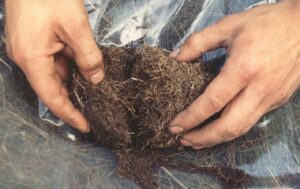In single-layer forest stands of medium or old age, an increase in exposure to light and therefore increased soil temperature can support an extensive presence of the subtype Rhizo Moder, which is mostly linked to the occurrence of a dense sward of wavy hair-grass (Deschampsia flexuosa) or reed-grass (Calamagrostis sp.). In pine and oak stands, dwarf shrubs (e.g., bilberry and cranberry) can also occur with high coverage. Rhizo Moder develops from Mor and Moder humus forms. Their original Oh horizon is loosened and increasingly mineralised due to intensive rooting and aeration. A differentiation between Odf horizons and Odh horizons and often also between Odh horizon and the uppermost Ah horizon is difficult. The fine organic matter and partly also the Of material are distributed within the root felt. Usually, the CN ratio of the Oh is >22, under dwarf shrubs >25. The Ah horizon can also be densely rooted. Distinct features are:
-
Ol horizon is present all year round and
-
Odf horizon above Odh horizon is present all year round or features of both horizons (Odf + Odh) exist parallel all year round and
-
a thin Ah horizon or Ee-Ah horizon or Ah-Ee horizon occurs.

